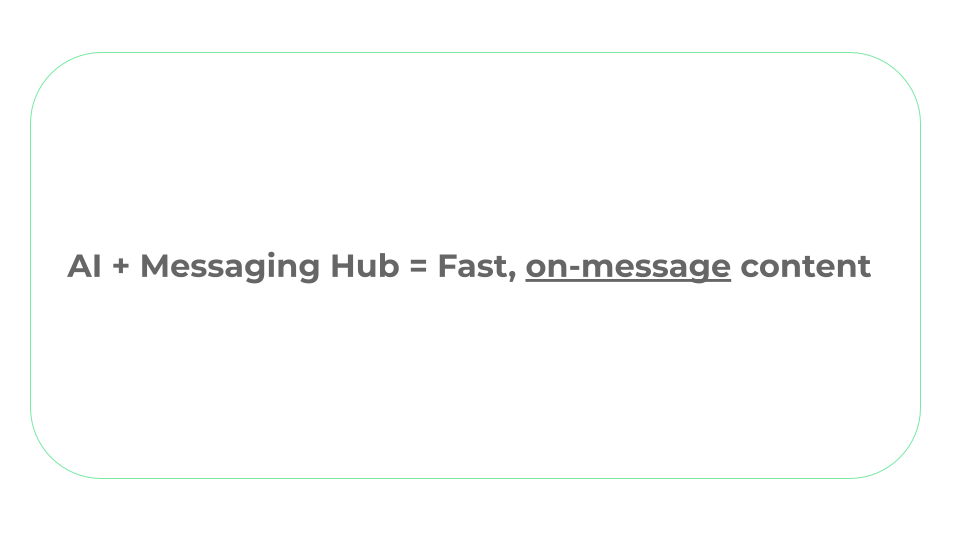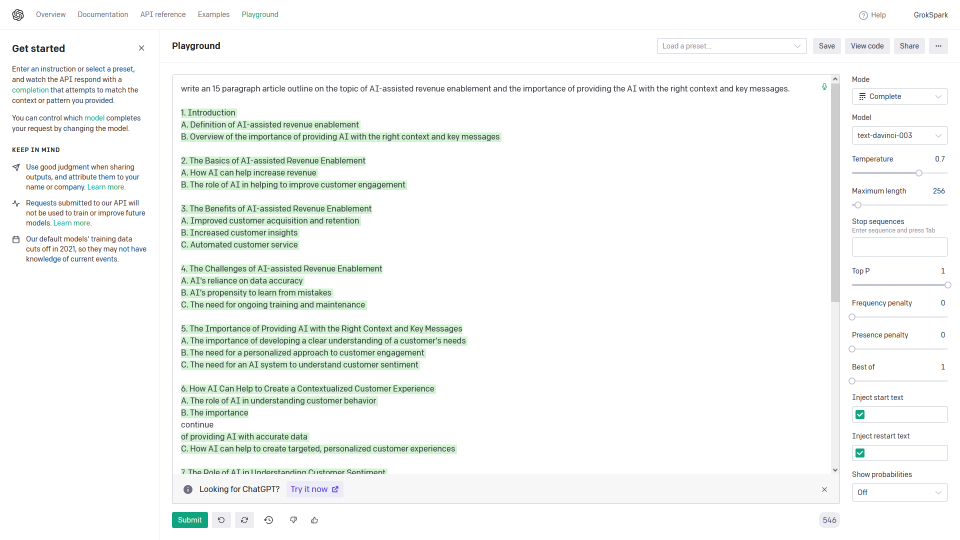The blog post below was created using vanilla AI (not GrokSpark). It’s an experiment showing an example of what AI can (and can’t) do to help create longform content.
What AI did:
- ~50% of the text was created using OpenAI
- Suggested a few options for the post outline
- Initial draft
- Reworded a few paragraphs
What human did:
- Initial prompt to request outline
- Prompt iterations to refine outline
- Prompt iterations to refine draft
- Edit draft/ rewrite parts
- “Bulletize” stuff
- Add images
- Write this italicized section
AI for sales and marketing content might be the next marketing automation frontier. However, giving AI instructions to write a blog post on a topic and outline without any other human input is not likely to get you the final product. But it WILL give you something helpful. If staring at a blank document is more daunting than editing something generic, AI can provide a lot of value as a writing assistant.
Can AI create all your sales and marketing content?
With AI technology advancing at unprecedented speeds, it shouldn’t surprise anyone to know that AI has already begun to revolutionize the way marketers and salespeople create content. The latest AI tool, GPT (Generative Pre-trained Transformer) is the most powerful yet. It gives businesses the apparent promise of being able to create compelling marketing and sales content quickly and effectively. However, the key question remains: can GPT itself provide truly relevant content without the help of human intervention? The short answer is probably not.
AI for revenue enablement defined
In order to understand why solely using AI without any guidance from a company’s messaging or marketing strategy is likely a bad idea, we must first define what AI-assisted content for revenue enablement is. Simply put, it’s the utilization of artificial intelligence to create marketing and sales content.

- Creates “decent sounding” content quickly
- Can handle a wide range of sales and marketing content requests
Overview of AI and its applications to Sales and Marketing Content
AI has become increasingly prevalent in many aspects of business operations due its ability to automate mundane tasks. These tasks include product cataloging and customer segmentation. In terms of Sales and Marketing Content creation, however, there is still some debate about whether or not AI alone can be used effectively without any human input. While it’s true that GPT can generate large amounts of copy quickly, it may lack specificity and fail to capture the nuances necessary for compelling content. This content should be specific to your company and its products. For that reason, using human-enhanced AI may be necessary. It can create relevant content that not only meets your customers’ needs, but also succeeds in communicating the information and narratives consistent with your company’s objectives.The problem with vanilla AI
When using vanilla AI (i.e., only using artificial intelligence without any human input), companies are essentially looking at generated text that comes from whatever data it’s trained on. In the case of GPT, it’s trained on a very large dataset, but still isn’t likely on its own to be very effective when it comes to sales or marketing efforts. For example, while vanilla AI may be able to come up with catchy phrases like ‘innovate faster’ or ‘engage more customers’ – these don’t necessarily say anything specific about what your product does or how it can solve a customer problem better than another solution out there on the market. Even in mature markets, vanilla AI is likely to only be able to cover “table stakes” capabilities and nothing that makes your solution unique. That kind of detail requires specific prompts from humans in order for an AI system like GPT to make sense of what type of content should be created within a certain context. Problems with vanilla AI for sales and marketing content:- Creates generic-sounding messaging…because that’s what it was trained on
- Hard to trust customer-facing teams to provide the right prompts to create quality content
Recommendation: It’s all about context
The challenge becomes how can your company create the specific prompts (or set of prompts in a chat) needed to create contextualized content. To develop content that is going to be helpful to your company the prompts need to not only give instruction to the AI about what type of content piece you are trying to create, but it also needs to provide the correct messaging. This way, your content actually reads as something that is coming from your company and not just something generic from the internet. Benefits of a Messaging Hub as a Source of Prompt Intelligence: To get around this issue, companies can use a messaging hub. Messaging owners can store all their key messages in one place to be used as prompt intelligence. This feeds into an AI system like GPT whenever new content needs to be created. A messaging hub acts as a single source of truth for the messaging. Users can be sure they are getting the best, up to date messaging for that specific situation. This is based upon the inputs from the user, such as audience, product, solution or any other filters that make it specific for the situation. This helps ensure all pieces of content remain consistent across departments. Not everyone knows the right messaging to use when creating any given piece of material.
Creating On-message Content with AI and Messaging Hubs
Combining advanced artificial intelligence with contextualized prompts provided by a messaging hub enables marketers and salespeople to leverage both speed and accuracy when creating quality content fast. No more spending hours manually crafting copy from scratch every time new material needs to be produced.
No more painstakingly iterating and editing vanilla AI-only content to insert the right messaging. Users can now feed their desired topics into an AI system like GPT along with their predefined messages stored in their messaging hub.
The machine generates high-quality customized pieces almost instantly according to their particular specifications each time they want something written up. This combination makes us able not only to write faster but also to ensure our writing remains on brand and consistent across multiple channels.
All our materials come straight from our messaging hub rather than relying solely on our own knowledge or memory when composing pieces from scratch every time we need something new. See this post AI Content for Sales and Marketing that is Actually On-Message to see how exactly we do this.
Conclusion
Overall, leveraging both advanced artificial intelligence such as GPT along with human-created prompts stored inside messaging hubs provides us with great opportunities for creating on-message sales and marketing content quickly and consistently across various channels. This makes it easier than ever before for teams looking for ways to increase revenue through well-crafted copywriting campaigns.
By providing pre-defined messages stored inside a centralized location that feed directly into an AI platform like GPT, businesses will no longer have to worry about manually crafting every piece they need. They can still keep everything consistent throughout all their materials, regardless if they’re sending out emails, pushing notifications via social media platforms, or having conversations over chatbot applications.
The next step in Revenue Enablement is here!


GPT can be very helpful in creating longform content, but needs human help